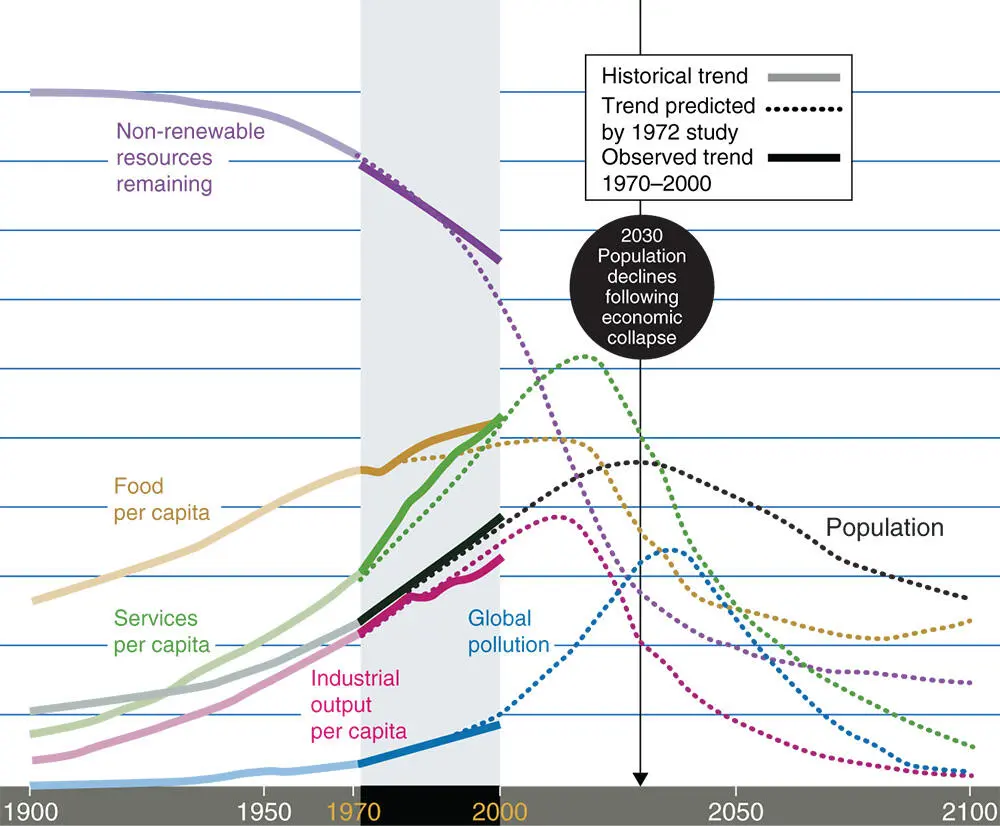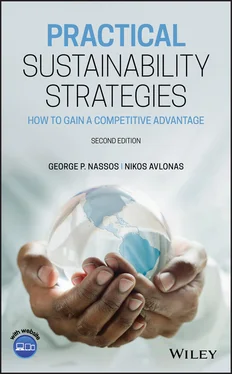In 1972, a team of MIT experts wrote a report titled The Limits to Growth and presented it to scientists, journalists, and others and shortly published it as a book. It was the first time that computer modeling was used to answer the question as to whether the population would outgrow the planet and the resources available. The purpose of the study was to show the interrelationship between global growth factors like population, resources, persistent pollution, food production, and industrial activity. Based on this study, they predicted that if human beings continued to consume more than the environment was capable of providing, there would be an economic collapse and a sharp decline in population by 2030, which is not too far away.
This topic of overshoot and collapse was addressed again in “Limits to Growth: A 30-Year Update” [9], which stated that “overshoot can lead to two different outcomes. One is a crash of some kind. Another is a deliberate turnaround, a correction, a careful easing down. We explore these two possibilities as they apply to human society and the planet that supports it. We believe that a correction is possible and that it could lead to a desirable, sustainable, sufficient future for all the world's peoples. We also believe that if a profound correction is not made soon, a crash of some sort is certain. And it will occur within the lifetimes of many who are alive today.”
Although the 1972 report seemed to focus on a very negative scenario, they looked at various changes that could avert a collapse. One positive variable was looking at technological changes that increased agricultural productivity, reduced pollution, and provided an increase in the available supply of natural resources. Technological advancements would have a positive impact, but this alone could not avert a collapse. Social and cultural changes would also be necessary to reduce consumption and stabilize population growth. Since it had been 40 years since the report, data were collected and compared with the predictions. To mark the 40th anniversary of the report, experts gathered to discuss the challenges ahead to into a sustainable future. Their concern was depicted in Figure 1.1[10], which shows that the world is following the predictions of the study.

FIGURE 1.1 Limits of growth.
You can see that with 30 years of data, pollution, industrial output, population, and services per capita are all increasing as expected. At the same time, the remaining non-renewable resources are decreasing a little slower (good), but food per capita is increasing a little faster than expected (bad).
The study was also concerned with sustainable development, which was defined by the notion that the developed nations can keep what they have while the poor people try to catch up. Or perhaps, keep on doing what we are all doing but through technological advances, we can expect less pollution and use fewer resources. Unfortunately, we are not succeeding with this expectation. We are currently consuming 70% more than what the earth is able to provide as explained earlier by the ecological footprint.
What we are consuming can be described as the different forms of industrial capital. This capital really refers to the machines and factories that produce the manufactured goods. These products manufactured by the industrial capital can be defined as industrial output. This industrial output derived from industrial capital can be used to generate service capital for the service industry, like banks, schools, and hospitals, which provide services for the people. Industrial capital is also converted to agricultural capital to generate agricultural output. Likewise, it is converted to resource-obtaining capital to generate resource output. In addition, industrial capital is used to manufacture consumer goods. As each of these industrial outputs continues to grow, there is a need for more capital to be invested in the factories and machines that serve each of the outputs. Consequently, there may be an exponentially growing requirement for industrial output to expand the capacity for production in the future. This leads to more and more consumption.
Another way of looking at overuse of the earth's resources is to talk about consumption. There is a great variation today in consumption of the many nations in the world. Consumption is defined as the needs of people for survival in terms of food, energy, materials, and the disposal of waste. The disparity in the consumption rate is that it is 32 times greater in the United States, Canada, Western Europe, Japan, and Australia than in the developing countries [11].
In 2019, the world population is estimated to be around 7.7 billion people of whom only about 1 billion live in the fully developed countries listed earlier. By the middle of this century, it is estimated that the world population could grow to 9 billion people, and there are questions as to whether the earth can support this number of people or will it collapse. It is not really a question of how many people are on this earth, but what is the consumption rate of these people?
People in third-world countries are aware of a major difference in the consumption rate per capita, although they probably don't know the magnitude of the difference. In general, their goal is to catch up to the developed countries, but if they believe their chances of catching up are hopeless, they could get frustrated, angry, or even participate in terrorist activities. Another option is to immigrate to a first world country like the United Stated and Western Europe, but then they would contribute to the consumption rate of that country.
If one considers the fastest growing economy in China, these people are already aspiring to increase their consumption to the 32 factor. If the Chinese were to succeed, it would be equivalent of doubling the world's consumption rate. If India were to do the same thing, the consumption rate would then triple. If the entire world had the same consumption rate as these first world countries, it would be the same as having 72 billion people on this planet at the current consumption rates—and there is no way the earth could handle this.
Since we are in no position to restrict the rest of world from improving their quality of life, the only answer is that the high consuming countries mentioned earlier must lower their consumption rate. But will they do it for the benefit of the rest of the world? Whether they want to or not, they must reduce their consumption rate because what they are doing today is not sustainable.
If these countries reluctantly agree to reduce their consumption rate, does it mean that they will have to reduce their quality of life? Definitely not! For example, the people in Western Europe consume half as much oil (gasoline) per capita than the people in the United States. But the Western European standard of living is considered higher than that in the United States in terms of life expectancy, healthcare, infant mortality, vacation time, quality of public schools, and several other criteria. Does a large gas-guzzling automobile really contribute positively to any of these quality-of-life factors? Probably not!
The current state of the environment can also be presented by looking at four major environmental issues: (i) water scarcity, (ii) energy sources, (iii) climate change, and (iv) population growth.
Water is a natural resource with a finite quantity. The amount of water on this planet 2000 years ago is the same as it is today, but the population during this time interval has gone from approximately 150 million to over 7 billion. But of all the water on the earth, how much is readily available to all of the living creatures? Figure 1.2[12] provides a summary of the current situation.
Читать дальше













